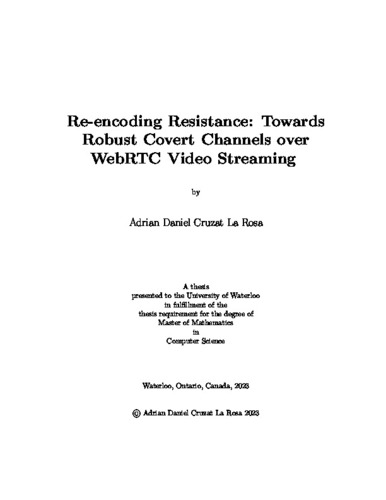| dc.description.abstract | Internet censorship is an ongoing phenomenon, where state level agents attempt to control the free access to information on the internet for purposes like dissent suppression and control. In response, research has been dedicated to propose and implement censorship circumvention solutions. One approach to circumvention involves the use of steganography, the process of embedding a hidden message into a cover medium (e.g., image, video, or audio file), such that sensitive or restricted information can be exchanged without a censoring agent being able to detect this exchange. Stegozoa, one such steganography tool, proposes using WebRTC video conferencing as the channel for embedding, to allow a party within a restricted area to freely receive information from a party located outside of this area, circumventing censorship. This project on itself, is an extension of an earlier implementation, and it assumes a stronger threat model, where WebRTC connections are not peer-to-peer but instead mediated by a gateway server, which may be controlled, or influenced, by the censoring agent. In this threat model, it is argued that an attacker (or censor) may inspect the data being transmitted directly, but has no incentive to change the video data.
With our work, we seek to challenge this last assumption, since many applications using this WebRTC architecture can and will in fact modify the video, likely for non malicious purposes. By implementing our own test WebRTC application, we have shown that performing video re-encoding (that is decoding a VP8 format video into raw format and then back) on the transmitted data, is enough to render an implementation like Stegozoa inoperable. We argue that re-encoding is commonly a non-malicious operation, which may be justified by the application setup (for example to perform video filtering, or integrity checks, or other types of computer vision operations), and that does not affect a regular non-Stegozoa user. It is for this reason, that we proposed that re-encoding robustness is a necessary feature for steganographic systems.
To this end, first we performed characterization experiments on a popular WebRTC video codec (VP8), to understand the effects of re-encoding. Similarly, we tested the effects of this operation when a hidden message is embed in a similar fashion to Stegozoa. We were able to show that, DCT coefficients, which are used commonly as the target for message embedding, change enough to cause loss of message integrity due to re-encoding, without the use of any error correction. Our experiments showed that higher frequency Discrete Cosine Transform (DCT) coefficients are more likely to remain stable for message
embedding after re-encoding. We also showed that a dynamically calculated embedding space (that is the set of coefficients that may actually be used for embedding), akin to Stegozoa’s implementation, is very likely to be different after re-encoding, which creates a mismatch between sender and receiver.
With these observations, we then sought to test a more robust implementation for embedding. To do so, we combined the usage of error correction (in the form of Reed-Solomon codes), and a static embedding space. We showed that message re-transmission (that is, embedding in multiple frames) and error correction are enough to send a message that will be received correctly. Our experiments showed that this can be used as a low-bandwidth non time-sensitive channel for covert communications. Finally, we combined our results to provide a set of guidelines that we believe are needed to implement
a WebRTC based, VP8 encoded, censorship circumvention. | en |

